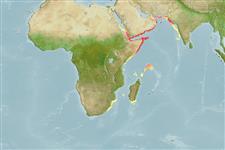Environment: milieu / climate zone / depth range / distribution range
Écologie
marin bathydémersal; profondeur 179 - 300 m (Ref. 9611). Deep-water
Western Indian Ocean: Irregularly distributed off the east and west coasts of India. Also known from off Socotra and the mouth of the Gulf of Aden.
Taille / Poids / Âge
Maturity: Lm ? range ? - ? cm
Max length : 23.5 cm TL mâle / non sexé; (Ref. 49326); common length : 16.0 cm TL mâle / non sexé; (Ref. 30573); poids max. publié: 170.00 g (Ref. 54802)
Found in deep water, forming small schools (Ref. 30573). Minimum depth from Ref. 58018.
Life cycle and mating behavior
Maturities | Reproduction | Spawnings | Egg(s) | Fecundities | Larves
Haedrich, R.L., 1984. Centrolophidae. In W. Fischer and G. Bianchi (eds.) FAO species identification sheets for fishery purposes. Western Indian Ocean (Fishing area 51). Vol. 1, FAO, Rome. (Ref. 9611)
Statut dans la liste rouge de l'IUCN (Ref. 130435)
Menace pour l'homme
Harmless
Utilisations par l'homme
Pêcheries: intérêt commercial mineur
Outils
Articles particuliers
Télécharger en XML
Sources Internet
Estimates based on models
Preferred temperature (Ref.
123201): 13 - 19, mean 15.7 °C (based on 7 cells).
Phylogenetic diversity index (Ref.
82804): PD
50 = 0.5156 [Uniqueness, from 0.5 = low to 2.0 = high].
Bayesian length-weight: a=0.00851 (0.00532 - 0.01361), b=3.12 (2.98 - 3.26), in cm total length, based on LWR estimates for this species & (Sub)family-body (Ref.
93245).
Niveau trophique (Ref.
69278): 3.5 ±0.5 se; based on size and trophs of closest relatives
Résilience (Ref.
120179): Milieu, temps minimum de doublement de population : 1,4 à 4,4 années (Assuming tmax>3).
Fishing Vulnerability (Ref.
59153): Low vulnerability (14 of 100).
